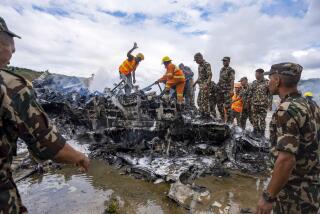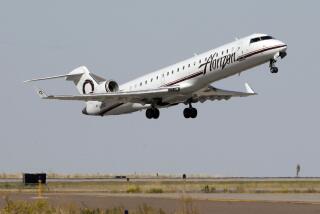Cockpit, indeed. Feathers fly aloft
- Share via
NEW DELHI — The sight of airline cabin crews trying to mollify enraged passengers has become all too common. But a recent Air India flight added a twist when crew members mid-flight started punching each other in front of startled passengers.
Accounts of what happened differ now that everyone’s back on the ground. Exactly who started the brawl and why got a bit lost in the clouds, though one flight attendant has accused a crew member of trying to molest her.
What no one disputes is that with New Delhi-bound Flight IC-844 cruising at 30,000 feet over Pakistan around 4 a.m. Saturday, the cockpit and cabin crews broke into fisticuffs. The ruckus spilled from the cockpit into the galley area in full view of the 106 passengers, prompting the pilot to threaten an emergency landing in Karachi, the commercial capital of India’s longtime adversary.
The flight managed to stay on course from the United Arab Emirates to the Indian city of Lucknow and then Delhi.
The pilot and chief purser will probably stay on terra firma for a while following their suspension Tuesday by Air India pending an investigation into the fight and allegations of sexual harassment.
“What a scandal, man,” said A.J.S. Walia, a former Indian vice air marshal, now head of Sikorsky Aircraft’s Indian operation. “What an immature act on everyone’s part.”
With regulators, analysts and the media fretting over the safety implications, the flag carrier quickly sought to reassure the public that the cockpit was never unmanned. At least one media report suggested, however, that both pilots were well out of their seats during the melee.
Police are probing alleged “assault or use of criminal force against a woman with intent to outrage her modesty.”
A spat started at Sharjah airport in the United Arab Emirates during a preflight check, according to Indian media, official statements and information leaked from an ongoing investigation.
Based on flight attendant Komal’s version -- the 24-year-old provided only her first name -- her takeoff announcement angered flight commander Ranbeer Arora, who called her into the cockpit and, along with copilot Aditya Chopra, sharply criticized her, making her feel “uncomfortable as a woman.”
Komal said she left the cockpit and explained to flight purser Amit Khanna what had happened. The two were then called back into the cockpit, Komal told reporters, at which point the pilots became aggressive and pushed her out, bruising her and leaving the purser and pilots to go at it.
Another flight attendant, Chhavi Jaggarwal, said in a statement that Arora hit Komal and that the two pilots used abusive language and appeared livid that Komal hadn’t greeted them respectfully.
“She was totally shaken up and was crying and she had bruises on her hand as if she was manhandled,” Jaggarwal said. “Even [business-class] passengers were standing and observing everything.”
In his version, the flight commander said he queried Komal about her tardiness in completing various procedures. A few minutes later, purser Khanna banged aggressively on the cockpit door, entered and used “un-parliamentary language.” When copilot Chopra rose to evict Khanna, Arora said, the copilot was manhandled by Khanna, leaving Chopra’s lips bloody.
Whatever the details, the pilots would have been badly distracted, experts said. Furthermore, the incident took place around dawn when the body’s circadian rhythms tend to be at a low point.
“The commander should never have compromised safety,” said Sajed Mumtaz, a former Air India trainer and flight supervisor. “You wait and handle these problems on the ground.”
The incident reflects a long-standing divide between cockpit and flight crews. “Since time immemorial, pilots have always been highhanded,” said Bhavna Tiwari, a longtime flight attendant and now a teacher at the Frankfinn Institute of Air Hostess Training in New Delhi.
That said, the captain is boss, she added. And even if a flight attendant feels sexually harassed, she can back away or file a complaint with the union.
“This whole incident was a bit weird,” Tiwari said.
“I see things from the flight attendant’s perspective, but it’s essential to remain professional.”
Several aviation experts said they couldn’t remember a similar case of aircrew rage. The closest recent incident may have been in October 2008, when the heir to the French fashion house Hermes, Mathias Guerrand-Hermes, allegedly grabbed at an Air France pilot’s crotch in an apparently drunken midair attack.
Air India, a former monopoly with an aging fleet and a poor on-time record, has struggled in recent years to compete with lower-cost private airlines.
Saturday’s fight came a few days after the government stepped in to halt a four-day pilots strike, nixing the carrier’s bid to cut the wages of many of its 32,000 workers -- twice the staff needed, by some accounts -- in an attempt to pare its $3 billion in accumulated losses.
“This airline is a disgrace. They’ve ground it into the ground,” said Madhu Kishwar, head of a women’s advocacy group, who had just canceled her ticket to New York. “I think this airline should die, and I’m doing my small part to make it happen.”
State-owned Air India, which some critics have dubbed a white elephant, has had several mishaps over the years. India badly needs an independent regulator and safety board, said safety expert Mohan Ranganathan, a former Air India pilot.
In the mid-1980s, a disgruntled flight crew whose two members weren’t talking failed to deploy their aircraft’s landing gear on arrival in Kolkata. No one was killed. Their licenses were revoked, Ranganathan said, but political connections and threats of a lawsuit saw them reinstated.
In June 2008, Air India flight IC-162 from Dubai, United Arab Emirates, overshot the Mumbai airport by 45 miles after its pilots fell asleep. The “nap in the sky” ended when air traffic controllers jolted the pair awake by causing a loud buzzer to go off in the cockpit.
This year, an Air India flight narrowly missed colliding with the president’s helicopter at the Mumbai airport.
Incidents such as these make some fear the airline may be complacent.
“They’ve been very lucky not to have a fatal incident since 2000,” when a pilot approaching the Patna airport lost control and crashed, killing 55 on board and five on the ground, Ranganathan said. “This gives them a false sense of security. I think they almost need another fatal crash to wake up.”
--
More to Read
Sign up for Essential California
The most important California stories and recommendations in your inbox every morning.
You may occasionally receive promotional content from the Los Angeles Times.










